Zotac GeForce GT 640 DDR3 Review: Glacial Gaming & Heavenly HTPC
by Ryan Smith & Ganesh T S on June 20, 2012 12:00 PM ESTCrysis, Metro, DiRT 3, Shogun 2, & Batman: Arkham City
Our first graphics test is Crysis: Warhead, which in spite of its relatively high system requirements is the oldest game in our test suite. Crysis was the first game to really make use of DX10, and set a very high bar for modern games that still hasn't been completely cleared. And while its age means it's not heavily played these days, it's a great reference for how far GPU performance has come since 2008
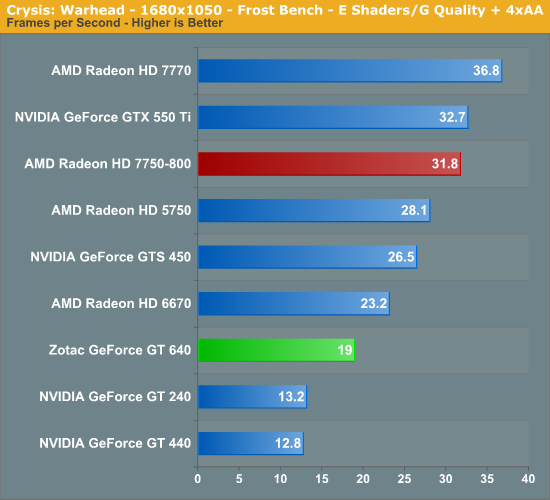
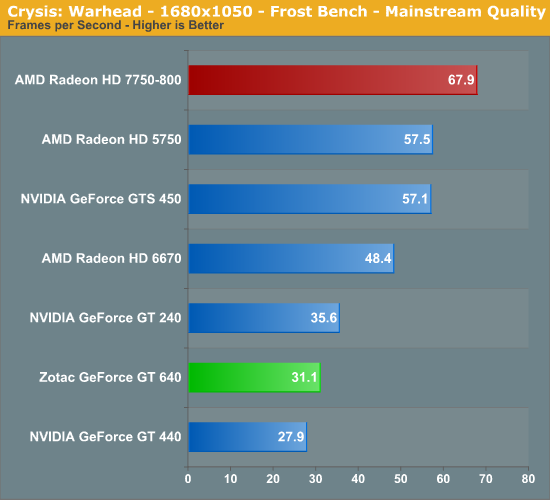
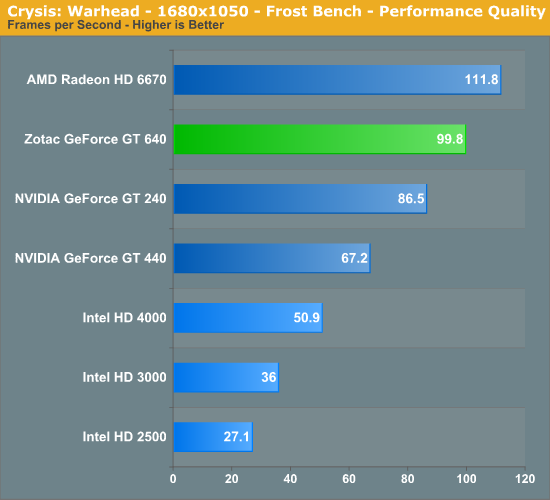
NVIDIA’s internal guidance on GT 640 DDR3 performance is that it should beat the Radeon HD 6670 by around 20%, however Kepler’s poor performance under Crysis means that isn’t going to happen here. At 31fps at 1680 with Mainstream quality the GT 640 is just barely playable here, with the Radeon HD 7750-800 (a similar sub-75W card) more than doubling its performance. Worse, the GT 640 actually loses to the GT 240 here, with NVIDIA’s two-generation old card beating it by 14%. To NVIDIA’s credit this happened to be the only test where that occurs, but this does a great job driving home the point that the GT 640 is heavily handicapped with DDR3.
On that note, given what we’ve seen with Kepler so far with GK104 cards and now with the GK107 GT 640, this further reinforces the idea that Crysis above all else a memory bandwidth hungry test. GTX 680 failed to greatly improve upon the GTX 580 when the two had similar amounts of memory bandwidth, and while the GT 640 does improve upon the GT 440 by quite a bit at times the fact that it loses to the GDDR5 GT 240 lends further proof to our theories. It will be interesting to see what happens here once we do see a GDDR5 card.
Finally, while we’ve focused thus far on the GT 640’s poor performance relative to its current competition, it’s not all bad news for NVIDIA. With Performance and Gamer quality in particular the GT 640 improves upon the GT 440 by a rather impressive 48% despite the fact that the two cards have similar memory bandwidth, reflecting just how much of an impact doubling the shader performance and quadrupling the ROPs can have.
On that note, as this happened to be one of only a couple of games where our test settings overlapped our iGPU test settings, we’ve also thrown in our Intel HD graphics numbers. The CPUs aren’t identical (all of our dGPU testing is on SNB-E), but we’re GPU limited to such a large degree that it doesn’t make a practical difference. NVIDIA wants to sell the GT 640 as an upgrade to i3/i5 systems with Intel’s HD graphics, and while its performance may be lacking compared to its competition, at the very least GT 640 handily surpasses any iGPU. Intel’s decision to ship most desktop IVB CPUs with HD 2500 means that GT 640 can nearly quadruple the IVB GPU’s performance under Crysis.
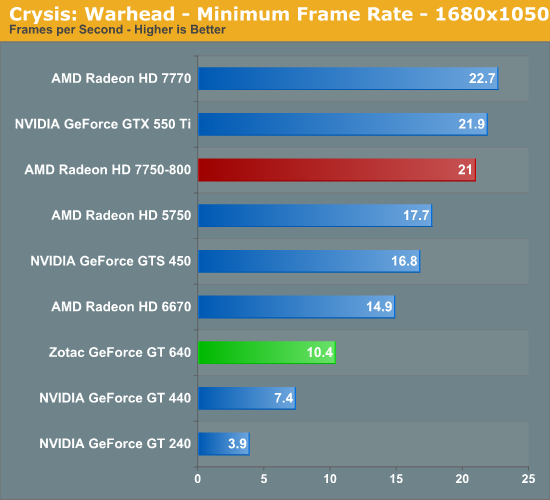
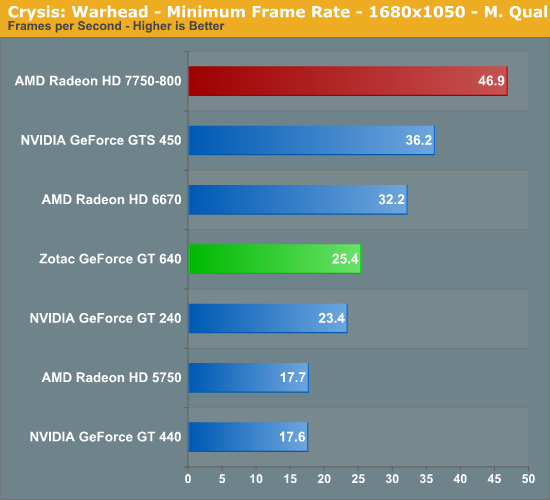
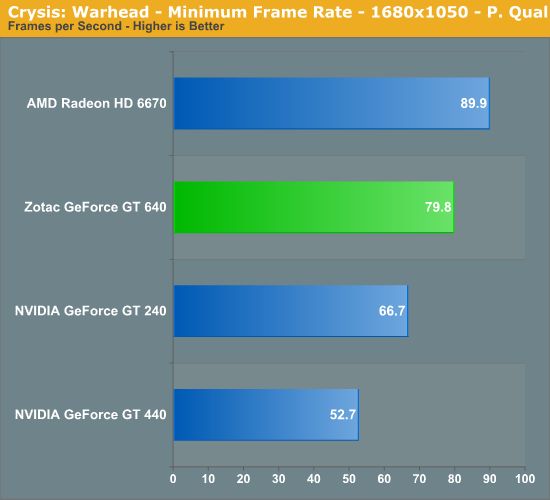
Looking at the minimum framerates the story is much the same. The GT 640 is well behind the 7750 and similar cards. At best it manages to beat the GT 240, most likely due to the former’s lack of total VRAM (it only has 512MB).
Metro
Paired with Crysis as our second behemoth FPS is Metro: 2033. Metro gives up Crysis’ lush tropics and frozen wastelands for an underground experience, but even underground it can be quite brutal on GPUs, which is why it’s also our new benchmark of choice for looking at power/temperature/noise during a game. If its sequel due this year is anywhere near as GPU intensive then a single GPU may not be enough to run the game with every quality feature turned up.
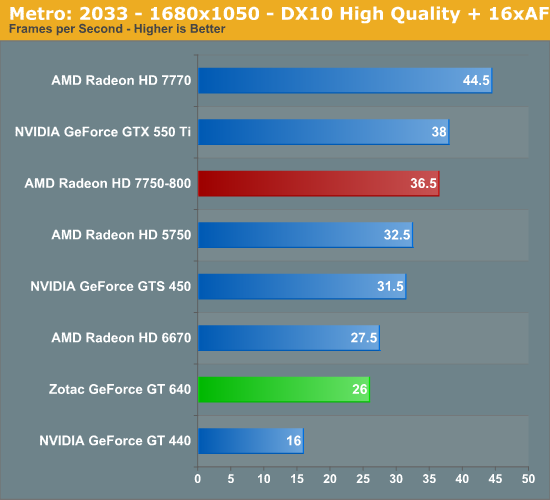
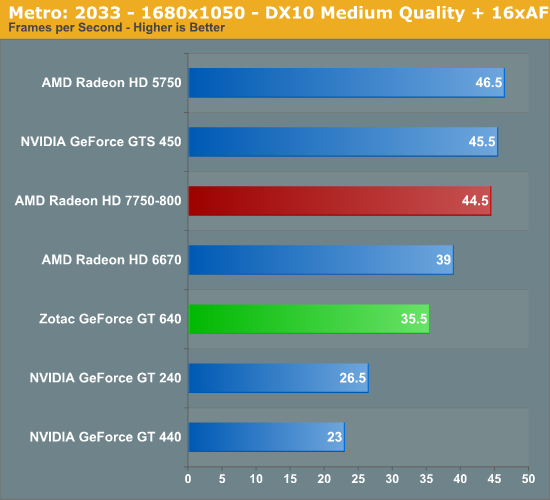
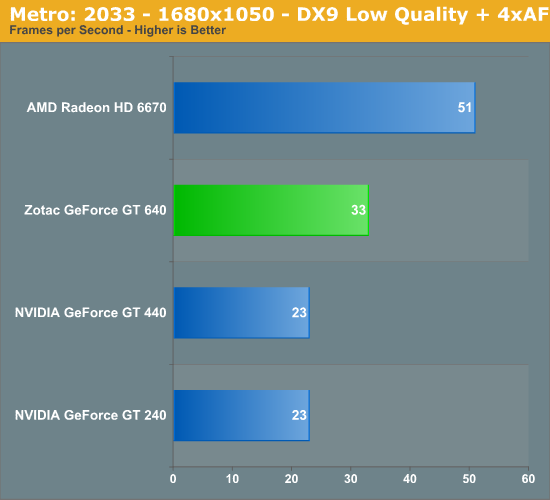
Relative to its competition the GT 640 improves slightly over what we saw in Crysis, but it’s still trailing the Radeon HD 6670, never mind the 7750. Performance has improved by over 50% over the GT 440, which is enough to push us past 30fps at 1680 with medium quality settings, but that’s as much as NVIDIA’s going to get out of the GT 640 here.
DiRT 3
DiRT 3 is our next DX11 game. Developer Codemasters Southam added DX11 functionality to their EGO 2.0 engine back in 2009 with DiRT 2, and while it doesn't make extensive use of DX11 it does use it to good effect in order to apply tessellation to certain environmental models along with utilizing a better ambient occlusion lighting model. As a result DX11 functionality is very cheap from a performance standpoint.
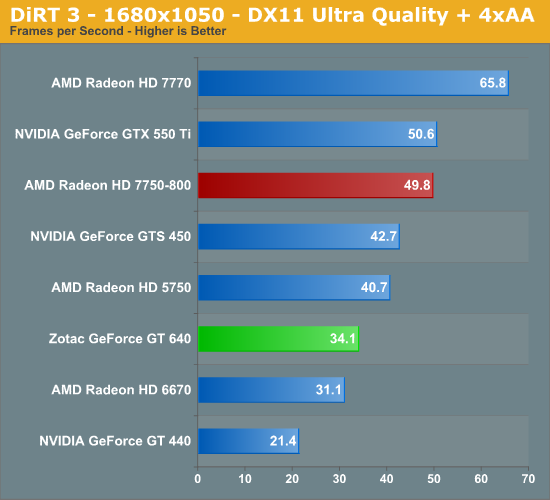
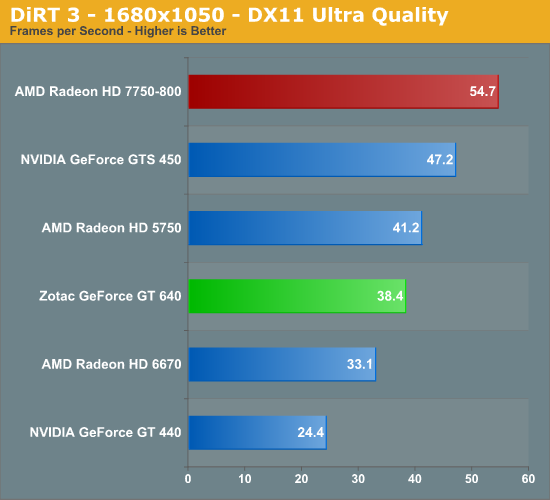

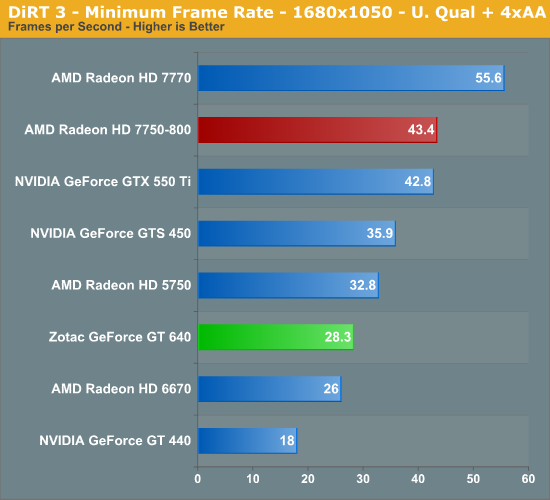
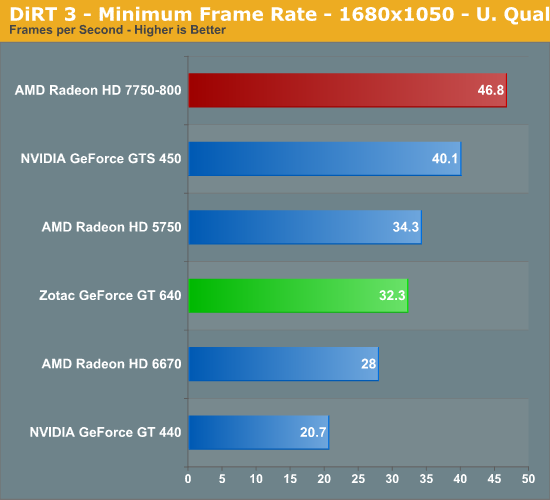
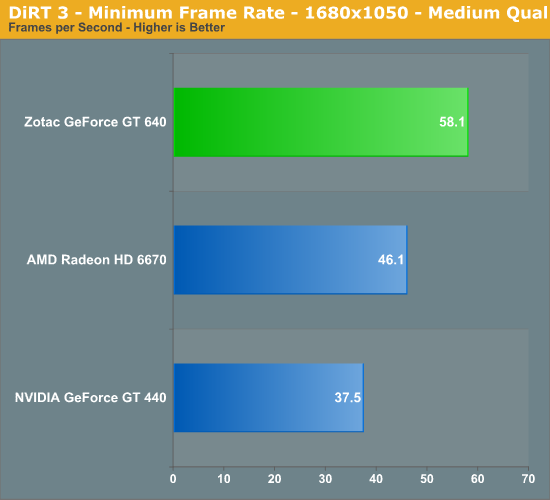
DiRT 3 is traditionally a game that favors NVIDIA here, and while the GT 640 finally surpasses the 6670, it’s by no means a great showing for the GT 640. Again it’s handily beaten by the 7750 and GTS 450, and for as light as DiRT 3 is, we still can’t even break 40fps at 1680 Ultra quality without AA. To achieve 60fps here it’s necessary to turn it down to Medium quality. Elsewhere performance relative to the GT 440 has increased by nearly 60%, which is a big jump for NVIDIA but not enough to surpass their competition.
Total War: Shogun 2
Total War: Shogun 2 is the latest installment of the long-running Total War series of turn based strategy games, and alongside Civilization V is notable for just how many units it can put on a screen at once.
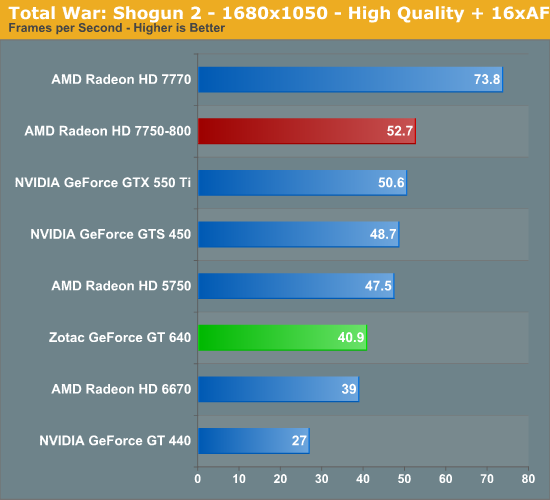
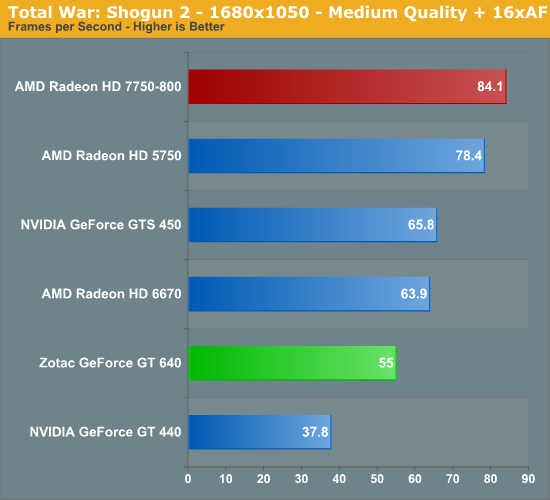
Under Shogun the story is much the same. The GT 640’s performance relative to the anemic GT 440 has greatly improved, jumping up by upwards of 50%, but it trails everything faster than a Radeon HD 6670. At the very least Shogun 2 is a relatively non-intensive game at 1680, so even at high quality the GT 640 is still achieving better than 40fps.
Batman: Arkham City
Batman: Arkham City is loosely based on Unreal Engine 3, while the DirectX 11 functionality was apparently developed in-house. With the addition of these features Batman is far more a GPU demanding game than its predecessor was, particularly with tessellation cranked up to high.
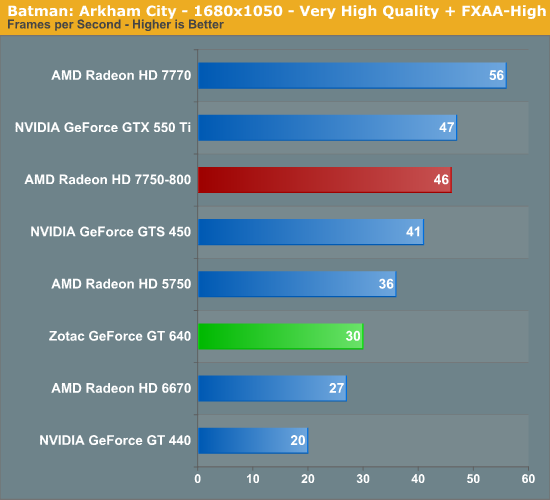
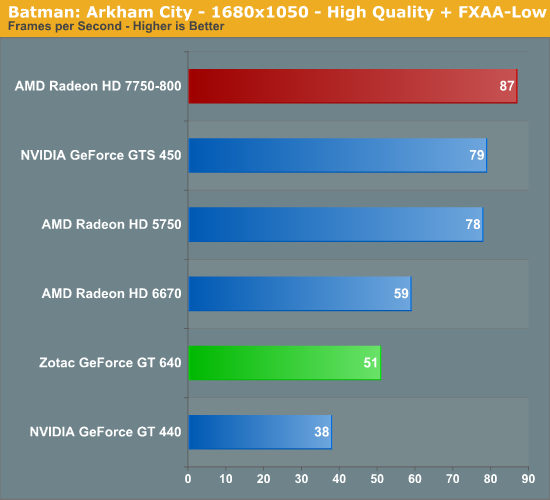
Batman: Arkham City is another game that traditionally favors NVIDIA’s GPUs, but again this isn’t much of a help here. At 1680 with Very High quality the GT 640 can just crack 30fps, and if we drop down to High quality that becomes a far more playable 51fps. But at the same time this leads to it greatly trailing the usual suspects at all configurations, and even the 6670 pulls ahead at High quality. Even the performance gains relative to the GT 440 have tapered off a bit, with the GT 640 only picking up 34% at High quality.










60 Comments
View All Comments
HighTech4US - Wednesday, June 20, 2012 - link
At least hen the GT240 was released it came in both DDR3 and GDDR5.UNhooked - Wednesday, June 20, 2012 - link
I wish there was some sort of Video encoding benchmark. I have been told AMD/ATI cards aren't very good when it comes to video encoding.mosu - Thursday, June 21, 2012 - link
who told you that kind of crap ?Please check the internet.Rumpelstiltstein - Thursday, June 21, 2012 - link
Did this low-end offering really manage to pull off these kind of numbers? I'm impressed. Not something I would buy personally, but I would have no problems recommending this to someone else.Samus - Thursday, June 21, 2012 - link
DDR3....ruined a perfectly good chip.Deanjo - Thursday, June 21, 2012 - link
Noooooo! Come on, post some benchmarks as it is right now. Some of us do not want to wait for AMD to get their VCE in order. People have been waiting for VCE for months and there is no valid reason to hold off NVENC waiting for their competitor to catch up. When and if VCE support comes out then run a comparison then.
ganeshts - Thursday, June 21, 2012 - link
NVIDIA indicated that official NVENC support in CyberLink / ArcSoft transcoding applications would come in July only. Till then, it is beta, and has scope for bugs.Deanjo - Thursday, June 21, 2012 - link
So? That didn't prevent them benching trinity and it's encoding capabilities despite it all being beta there.http://www.anandtech.com/show/5835/testing-opencl-...
drizzo4shizzo - Thursday, June 21, 2012 - link
So... do these new cards still support HDTV 1080i analog signals for those of us who refuse to give up our 150lb 34" HDTV CRTs?ie. ship with a breakout dongle cable that plugs into the DVI-I port? If they don't ship with one can anyone tell me if they are compatible with a 3rd party solution? For it to work the card has to convert to the YUV colorspace. My old 7600gt *did* support this feature, but none of the new cards mention it...
Upgrading my TV also means buying a new receiver for HDMI switching to the projector, fishing cable in walls, and all manner of other unacceptable tradeoffs. Plus monay.
Thanks!
philipma1957 - Thursday, June 21, 2012 - link
I have a sapphire hd7750 ultimate passive cooled card.This card seems to be worse in every case except it is 1 slot not 2.
The passive hd7750 is 125 usd this is 110 usd.
I am not sure that I would want this until they make a passive version.